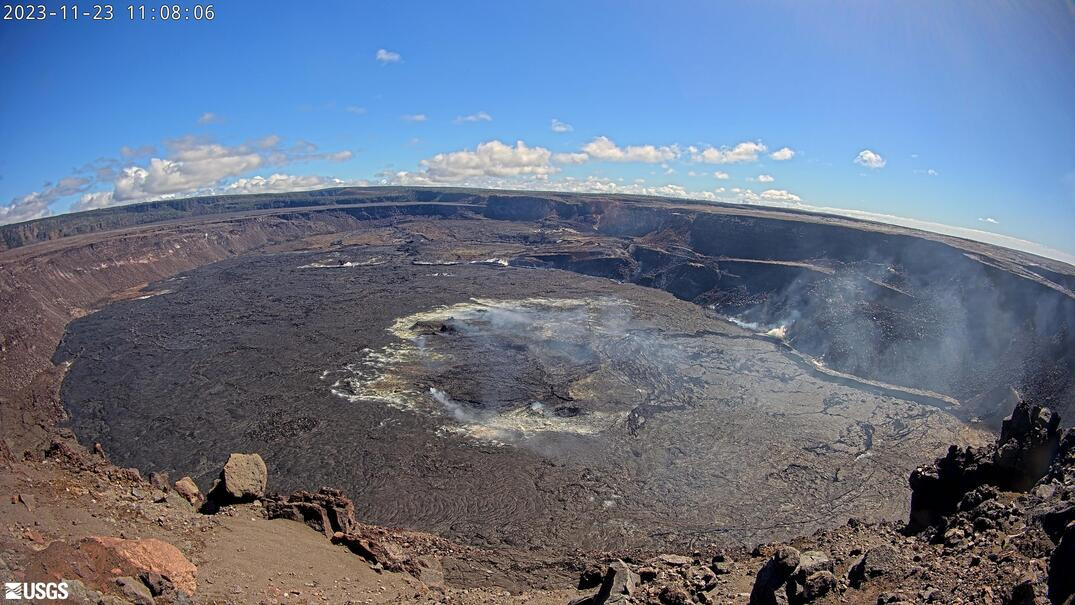(BIVN) – Kīlauea volcano is not erupting and remains at an alert level of ADVISORY.
“The low levels of seismicity that occurred throughout November 22 have continued over the past 24 hours with approximately 50 earthquakes occurring at Kīlauea,” the USGS Hawaiian Volcano Observatory wrote on Thursday morning. “Unrest may continue to wax and wane with changes to the input of magma into the area and eruptive activity could occur in the near future with little or no warning.”
Earthquakes are still being recorded on the upper East Rift Zone, and scientists say no unusual activity has been noted along the middle and lower sections of the ERZ.
Hawaiʻi Volcanoes National Park reopened the Chain of Crater Road and nearby sites on Wednesday, after Tuesday’s “brief seismic crisis” in the upper ERZ subsided. The area remains open to visitors today.
Seismicity also continues at low levels in the Southwest Rift Zone, with 15 earthquakes occurring over the past 24 hours. Mauna Iki Trail and the Kaʻū Desert Trail (south of the Footprints exhibit to the Mauna Iki Trail intersection) remain closed due to the volcanic unrest in the area.
From the USGS Hawaiian Volcano Observatory:
Activity Summary: Kīlauea volcano is not erupting. The low levels of seismicity that occurred throughout November 22 have continued over the past 24 hours with approximately 50 earthquakes occurring at Kīlauea. Unrest may continue to wax and wane with changes to the input of magma into the area and eruptive activity could occur in the near future with little or no warning. No unusual activity has been noted along the middle and lower sections of Kīlauea’s East Rift Zone.
Summit Observations: Low levels of seismicity that started on November 22 continue into the morning of November 23. In the past 24 hours, 5 earthquakes occurred in the summit region and 14 earthquakes in the upper East Rift Zone region.
The Uēkahuna summit tiltmeter, located northwest of the caldera, shows a flat to slightly increasing tilt over the past 24 hours. The Sand Hill tiltmeter, located southwest of the caldera, also shows a flat to slightly increasing tilt over the past 24 hours. Overall, the summit of Kīlauea remains at a high level of inflation, above the level reached prior to the most recent eruption in September 2023, and the highest level since the 2018 eruption.
Sulfur dioxide (SO2) emission rates remain low. Field observations found SO2 gas emmision of 100 tonnes per day on November 17. This is the same as an observation in October 2023.
The brief seismic crisis in the upper East Rift Zone subsided thoughout the day of November 21 greatly reducing any chance of eruptive activity, and seismicity remains at low levels today, November 23. There is currently no sign of an imminent eruption, and seismic activity in the region extending from the south margin of the caldera southwest to the Koa’e fault zone is also at low levels today, November 23. An increase in seismic unrest would be expected prior to any eruptive activity in this region. The onsets of previous summit eruptions have been marked by strong swarms of earthquakes caused by the emplacement of a dike 1-2 hours before eruptions and these have not been detected at this time.


by Big Island Video News11:30 am
on at
STORY SUMMARY
HAWAIʻI VOLCANOES NATIONAL PARK - Earthquakes are still occurring in the summit region and in the upper East Rift Zone region.